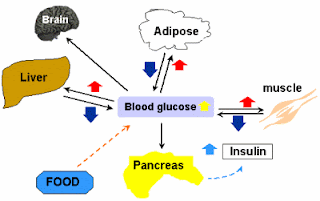 In our bodies there are clocks in addition to the Master clock located in the suprachiasmatic nucleus. In computers, there are multiple clocks too, and they are tightly coordinated. For example, Integrated circuits like AV 9155 generate multiple clock frequencies for different portions of a computer (e.g. bus clock, CPU clock, keyboard clock etc.). All these clock frequencies are well regulated, since ICs like AV9155 use 2 quartz crystals (14.318 MHz) which generates of all these frequencies (they have inbuilt circuitry for dividing/multiplying these frequencies to create other necessary frequencies).
In our bodies there are clocks in addition to the Master clock located in the suprachiasmatic nucleus. In computers, there are multiple clocks too, and they are tightly coordinated. For example, Integrated circuits like AV 9155 generate multiple clock frequencies for different portions of a computer (e.g. bus clock, CPU clock, keyboard clock etc.). All these clock frequencies are well regulated, since ICs like AV9155 use 2 quartz crystals (14.318 MHz) which generates of all these frequencies (they have inbuilt circuitry for dividing/multiplying these frequencies to create other necessary frequencies).Our bodies have their own version of these ‘crystal oscillators’, the BMAL1/CLOCK heterodimer. Since genes are present in all cells (leaving aside germ cells for a while, since they are haploid, and chiasma formation gives rise to gene rearrangement), theoretically all cells also has the machinery for BMAL/CLOCK generation. Thus in the periphery, where these genes are expressed, circadian oscillating mechanisms are automatically incorporated.
The role of peripheral circadian clocks is still uncertain. But it is known that the peripheral clocks regulate cell division, estrous cycles and glucose and lipid homeostasis. Lamia et al knocked out the BMAL1 gene in mice liver and observed that the liver was no longer able to pour sufficient glucose into the blood circulation for cellular activity, resulting in hypoglycemia. Normally, the liver produces glucose from lipids and amino acids in a process called neoglucogenesis; and from glycogen, a glucose polymer, by glycogenolysis, in the fasting phase, to make up for the dwindling blood glucose level. In liver specific BMAL1 deletion, this did not happen and the animal suffered from hypoglycemia, indicating the important role of the liver peripheral clock.
These peripheral clocks certainly need to be regulated too in order to achieve physiological harmony. The master clock in the suprachiasmatic nucleus might regulate these peripheral clocks by hormones and hemodynamic cues.
Gatfield et al used two groups of mice and inactivated BMAL1 in all their cells in one group (BMAL1-/-); and only in liver cells in the other group (L-BMAL1-/-) [the 2 minus signs indicate homozygous, or in both alleles, deletion/inactivation]. The mice in which all BMAL1 were deleted did not show any problem which glucose homeostasis, whereas those with only liver specific BMAL1 deletion had problem maintaining normal sugar level in the inactivity (fasting) phase. Thus the role of liver clock is undeniable. The hepatic oscillator synchronises on feeding cues, since feeding is related to circadian metabolism. In the L-BMAL1 knockout mice, both neoglucogenesis and glycogenolysis operated adequately, but the machinery for the pouring of glucose into the circulation, the final step that is carried out by glucose transporter 2 (GLUT2) is suboptimal. GLUT2 expression in L-BMAL1-/- rats is inadequate.
In BMAL1-/- mice, the master clock in the SCN was inactive along with all other peripheral clocks. This presumably abolished the circadian feeding responses and thus glucose homeostasis was minimally affected. It is as if both the SCN (master) and liver (slave) clocks gone wrong and they were fully asynchronous. But in the L-BMAL1 knockout mice, the SCN was OK and it expected the desired blood glucose level in the habitual feeding time, but the liver lacked GLUT2 to supply the required glucose in the bloodstream. UNITED WE STAND, we better synch!
Last modified: never
References:
Physiological significance of a peripheral tissue circadian clock. Katja A. Lamia, Kai-Florian Storch, and Charles J. Weitz doi:10.1073/pnas.0806717105
BMAL1 and CLOCK, Two Essential Components of the Circadian Clock, Are Involved in
Glucose Homeostasis. R. Daniel Rudic , Peter McNamara , Anne-Maria Curtis, Raymond C. Boston, Satchidananda Panda, John B. Hogenesch, Garret A. FitzGerald doi:10.1371/journal.pbio.0020377
1 comment:
i have joined your feed and look forward to seeking more of your nifty post.
plushy
www.n8fan.net
Post a Comment